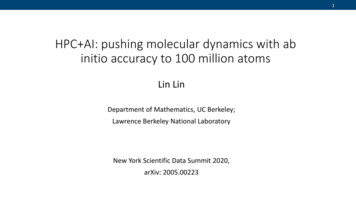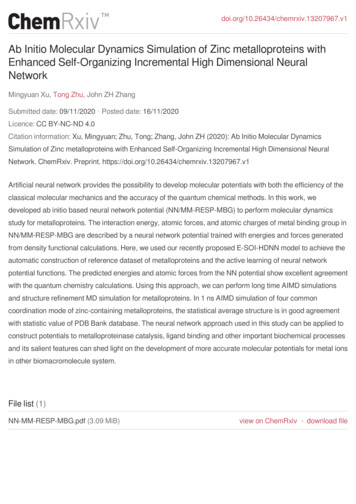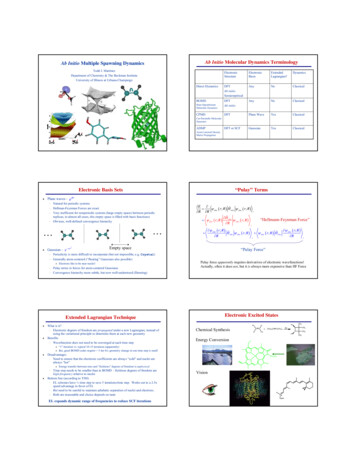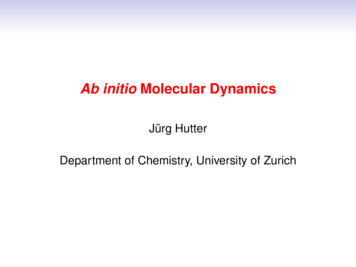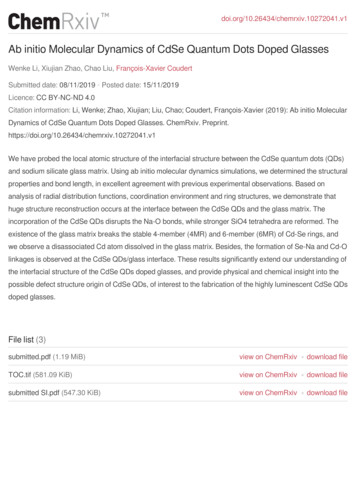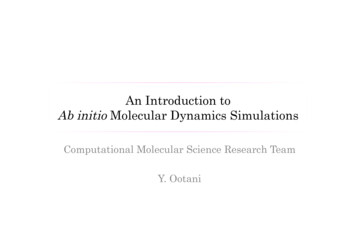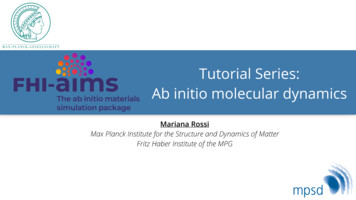
Transcription
Electrochemistry project, Chemistry Department, November 2006Ab-initio Molecular DynamicsSimulation
Outline Introduction¾ Ab-initio concepts¾ Total energy concepts¾ Adsorption energy calculation Project objective Ab-initio total energy calculation Density Functional Theory Implementation to total energy calculation Ionic relaxation (Geometry optimization)
Ab-initio conceptsComputationalAb-initio simulationClassical simulations and some theoriesuse experimental values, while in ab-initiocalculations no experimental value isneeded.Classical simulationsExperimentTheoryAb-initio - No experimental data in needed as an input for the calculation
Total energy conceptsAssumption: T 0K (no kinetics energy for nucleus) Total energy of an atom in gas phase Classical viewatomEtot Ee ion Ee eatomEtot e0Ve ion e0Ve er2r1 z1 i 1 ri i j 1 ri r j 3nucleuselectronsEatomtotWe use atomic unit:e0 1,14πεε 0 1atomTotal energy E tot 0 : The require energy to take apartall electrons from the nucleus
Total energy of a molecule in gas phasemolEtot Ee ion Ee e Eion ionmolEtot e0Ve ion e0Ve e ze0Vion ionrjRii 2, j 6molEtoti 2, j 26 z1 z2 i 1, j 1 Ri r j i , j 1 ri r j i j 1 Ri R j molTotal energy E tot 0 : The require energy to take apartall electrons AND nucleus
EmoltotEWhat is E Emoltotatomtot EatomtotIt is the binding energy of a molecule: the require energy to takeapart two atoms of a molecule
Adsorption energyDefinition: The require energy to take apart the adsorbate fromthe surfaceExample: CO adsorption on PtCO/PtEslab COtotClean Pt slabEslabtotCO in gas phaseCOEtot
Project ObjectiveHydrogen and CO adsorption energies on Pt(111),Pt(110) and Pt(100)
Ab-initio total energy calculation of a system of nucleons and electrons The electrons and ions are very small therefore quantum consider is neededApproximation 1: ions are much bigger compare to electrons - ions as classical particles. Electrons- Quantum particles - Wavefunction - Charge density n(r) - Schrödinger eq.Nucleons - Classical particles - Point charge - Newton (coulomb) lawions(classic)electrons(quantum)
Schrödinger equation for system of electronsH Ψ EΨ where Ψ is the total wavefunction of the system.Kohn-Sham orbitalsΨ ϕ1ϕ 2 .ϕ NNThe charge density is given byn( r ) ϕ i 2i 1H is the Hamiltonian.H T Ve e Vext Vext is the interaction with an external potential. In our case the external potential is justelectron-proton interaction:r-RizrRiNzVext [n] i 1 r Ri xyRi is the position of ions.
Ve-e is electron-electron coulomb interaction:zr-r’rn(r’)r’xVextn( r ')dr 'Ve e [n] r r' VextVextyVextCharge densityof electrons n(r)
H T Ve-e Vextx 99T is the kinetic energy of electrons of the interacting system.The bad news is that there no solution for T and Ψ therefore there is no solutionfor Schrödinger equation.
Density Functional Theory (DFT)Theory1: External potential is a unique functional of the density n(r). That means if we have asystem of electrons, the ground state density n0(r) corresponding to an external potential (likethe potential from the protons) Vext can not be reproduced using any other potential V’ext.Theory 2: The correct ground state density n0(r) minimizes the total energy functional.Interacting particles (electrons)Non interacting particlesH T Ve-e VextHs Ts VeffDFTVextVeffelectronsat ground state n0(r)non-interactingparticles n(r)if Etot Emin Æ n n0(r)
Based on the DFT many body problem of fully interacting particles in an external potentialVext is simply replaced by a system of non-interacting particles in a effective potential Veffgiving the same ground state charge density n0(r).Ts is now the kinetic operator of a non-interacting system with N particles whichcan be easily given by: 2 d 2Ts 2i 1 2m drNThe effective potential Veff is:Veff Ve-e Vext VxcVxc : The extra term which contains all the energy contribution which were not taking intoaccount in the transition from the interacting system to the non-interacting system. Vxc iscalled exchange-correlation potential
The exchange-correlation potential can be expressed as:Vxc [n] dE xc [n]dnwhere Exc[n] is the exchange-corralation energy.The above DFT is formally exact, but it is impossible to find a exact from for VxcThe most common approach is the Local Density Approximation LDAE xc [n] ε xc (n)n(r )drwhere εxc(n) is the energy of a homogeneous electron gas and it is known. Thereforethe Exc[n] and hence Vxc[n] are all known.Various approximations have been introduced in the course of the years to improve LDA. TheGeneralized Gradient Approximation (GGA) is one of those approximations which is more or lesscommonly accepted to be an improvement over LDA.In GGA approximation the Vxc depends not only on charge density n(r) but also on the magnitude ofthe gradient of the charge density n Vxc [n] Æ in GGA approximation Æ Vxc [n, n ]
Implementation to total energy calculationEtot Eel Eion ionIn order to calculate to Eel we need to solve the following Schrödinger equation.H s Ψ Eel Ψ(Ts Ve e [n] Vext [n] VXC [n])ϕ i Eϕ ii 1, 2, ., NNn( r ) ϕ i 2i 1The effective potential depends on the density, the density depends on Kohn-Sham orbitals(φi) and Kohn-Sham orbitals depends on the effective potential!!
Ion-ion interaction termEtot Eel Eion ionwhere Eion-ion is just the coulomb interaction between ionszZ2Eion 2i, j ,i j Ri Rj RjRixy
Trial charge density n(r)Set up HamiltonianH Ts Ve-e Vext Vxccalculate the orbitals ϕiand the totalenergy Etot from one-particle ShrodingerEquationnewϕnew,Ei ϕ in e w ϕ i 1 0 5YesOutputϕnew,Eel,n(r)iNoNn(r ) ϕnew 2ii 1
Basis set-Plane waveIn this section we are going to briefly explain how we can solve the Kohn-Sham equationand obtain the wavefunctions and energies. If we multiply both sides of the Kohn-Sham Eq.? by φ*i(r) and take an integral fromboth sides we gets: 2d2*ϕϕi (r ).dr ϕi* (r )(Ve e [n] Vext [n] Vxc [n])ϕi (r )dr εi ϕi* (r )ϕi (r )dr(r).idr 22m One way to solve the Kohn-Sham equation is to expand the wavefunction φi in aplane wave basis set. Using plane wave as a basis set has some advantagesand some disadvantage. The advantage of using the plane wave is that itwhich help us to simplify the above Kohn-Sham equation. ϕi (r ) Ci,k . exp(ik.r )k 1where mathematically the sum is over a infinite number of plane wave but of coursein practice we see that it already converges for a large number of plane wave. Bysubstituting this equation into the above Shrodinger equation and using thefollowing mathematical principal: exp(ik r ). exp(ik' r )dr δkk 'We end up with a matrix with Nmax x Nmax elements where Nmax is the number ofthe plane waves.Nmax depends very much to the size of your system. i.e. number of atoms in yoursystem and also the elements you use. it can be as big as 1e 5 number of planewaves. In order to get φi and εi from the matrix we need to diagonal it which ofcourse needs a powerful computer or even several computers working as parallel.Reminding: When φi and εi are calculated in the next iteration a new charge densityshould be constructed and again a new matrix should be diagonalized. Usually10-30 iterations in needed to get the total energy of the system self consistently.
The calculated total energy in this way depends very strongly on the position of the tions. The position of the atoms is given by you, and it is not precise enough. Therefore the total energy calculation will be absolutely wrongSolutionGeometry optimization¾ It is possible to calculate the force on each ion from the total energy calculationFi dE totdR i¾ we can move the ions a little bit along the forces and redo the total energy calculation¾ we repeat the above calculation until the total force on ions becomes almost zeroInitial configurationFionNext ioniciterationNext ioniciterationFion
Trial charge density n(r)Set up HamiltonianH Ts Ve-e Vext Vxccalculate the orbitals ϕnewand the totalienergy Etot from one-particle ShrodingerEquationϕnew,Ei ϕ in e w ϕ i 1 0 5Caculate the forceon ions FionYesYesNoNn(r ) ϕnew 2ii 1EndFion 10-3NoMove the ionsalong the forces
References: W. E. Pickett, Pseudo potential methods in condensed matter application, Computer Phys. Report, 9:115, 1989 E. Kohn and L. J. Sham., Self-consistent equations including exchange and correlation effects, Phys. Rev., 140:A1133, 1965 R. O. Jones and O. Gunnarsson. The density functional formalism, its application and prospects:, Rev. Mod.,Phys., 61:689, 1989 Ata Roudgar, Local reactivity of bimetallic overlayer and cluster systems, PhD thesis,http://www.sfu.ca/ aroudgar/Thesis/
Ab-initio total energy calculation of a system of nucleons and electrons The electrons and ions are very small therefore quantum consider is needed Approximation 1: ions are much bigger compare to electrons - ions as classical particles. Electrons - Quantum particles - Wavefunction - Charge density n(r) - Schrödinger eq.

